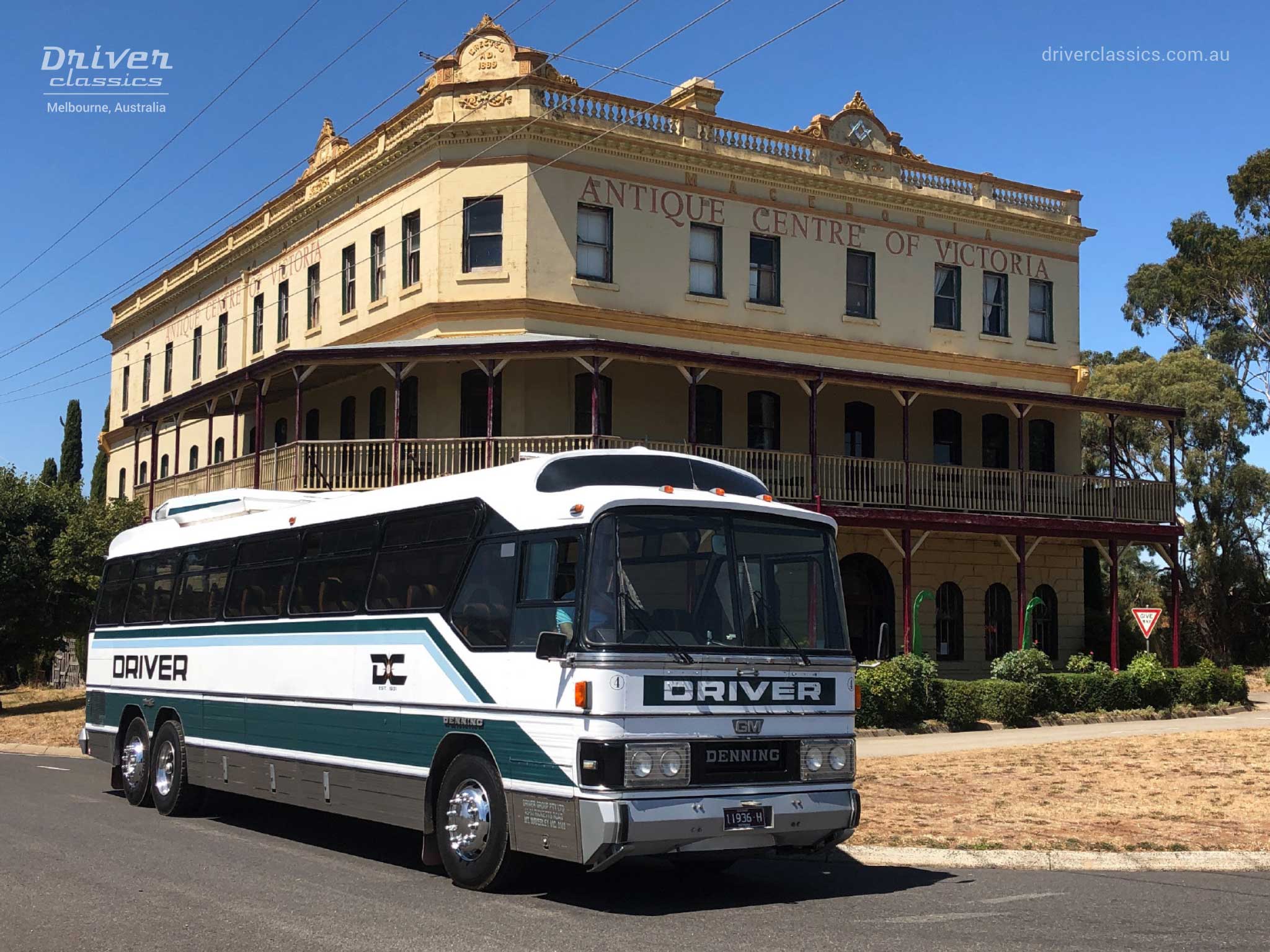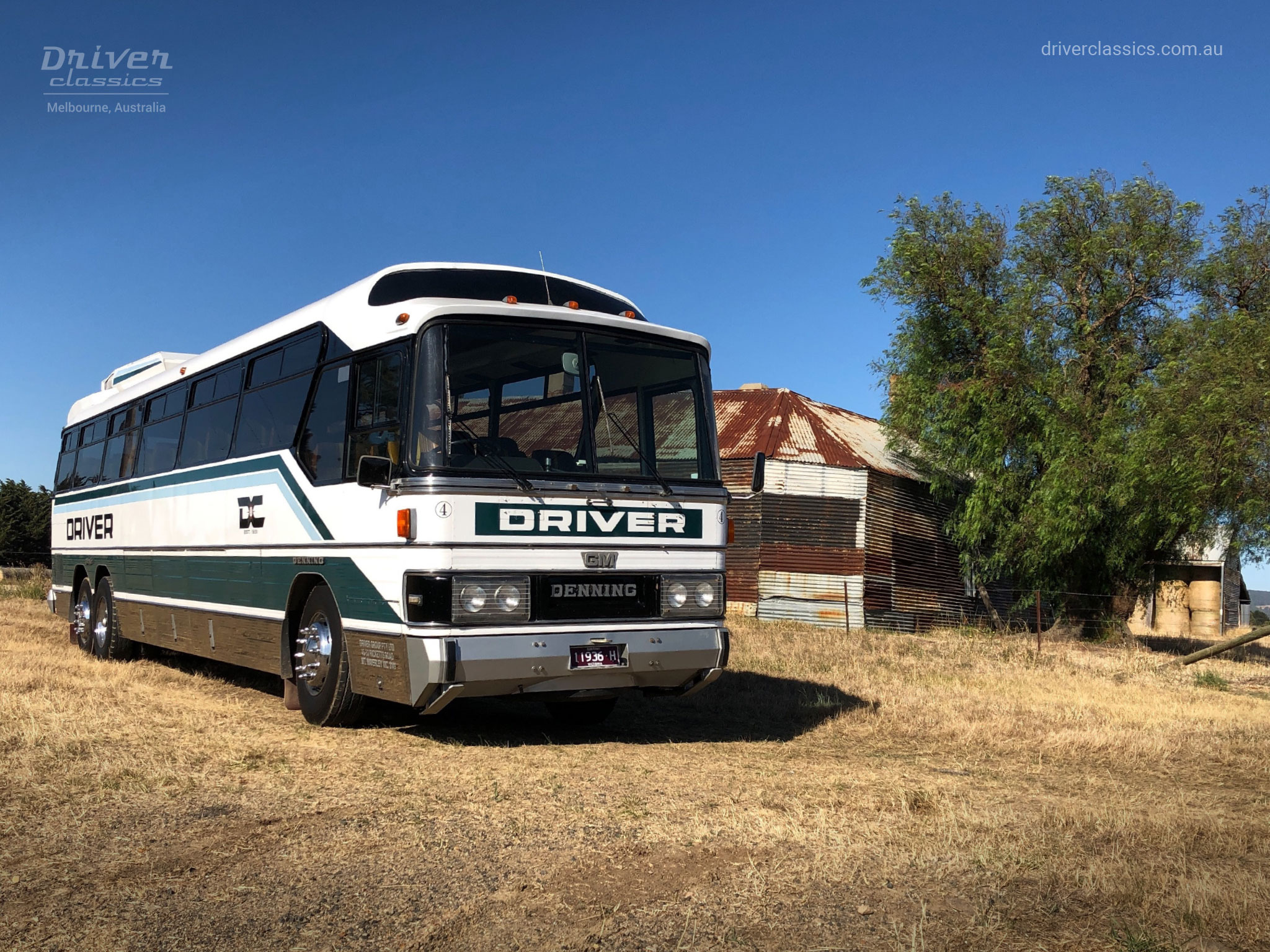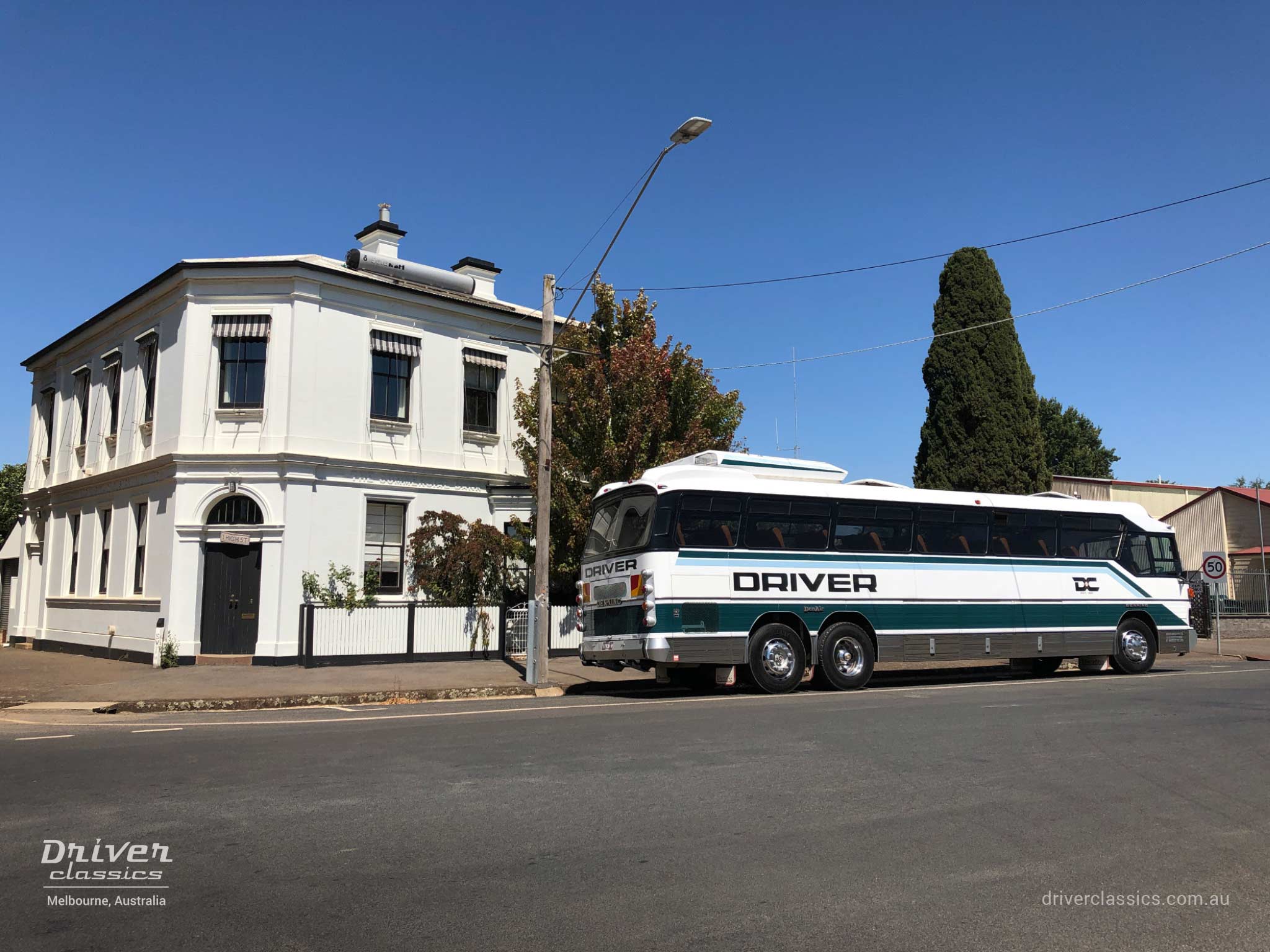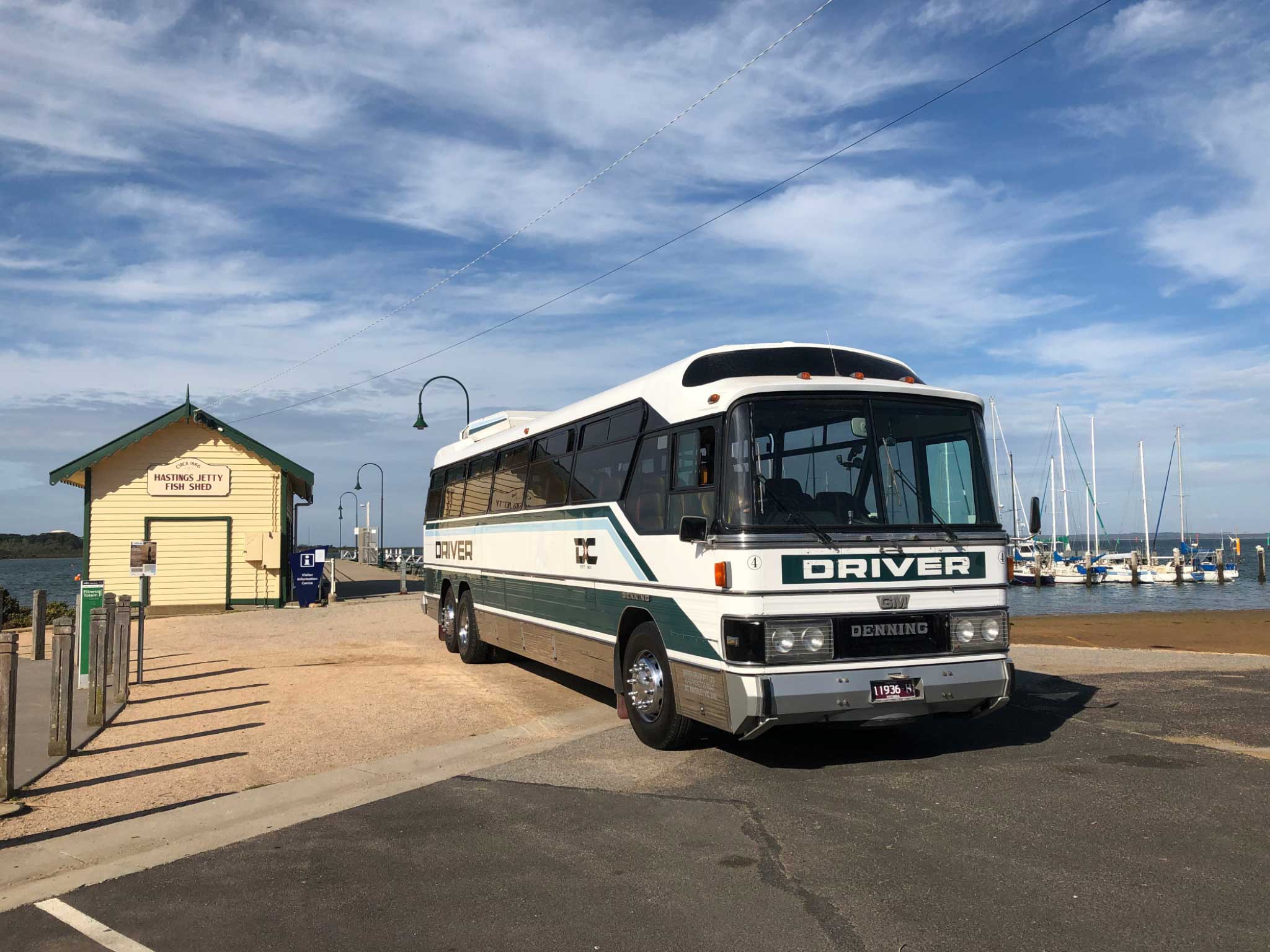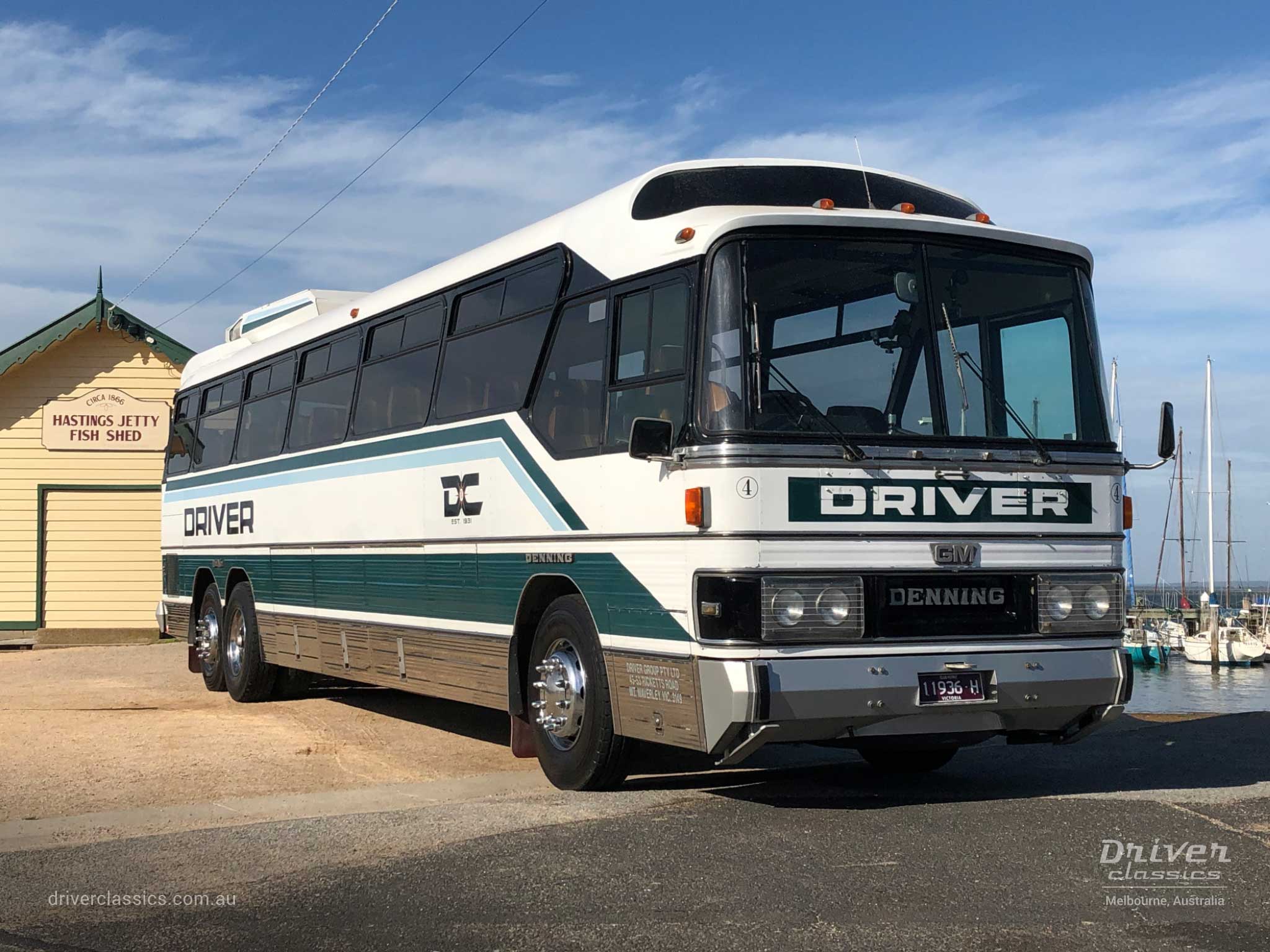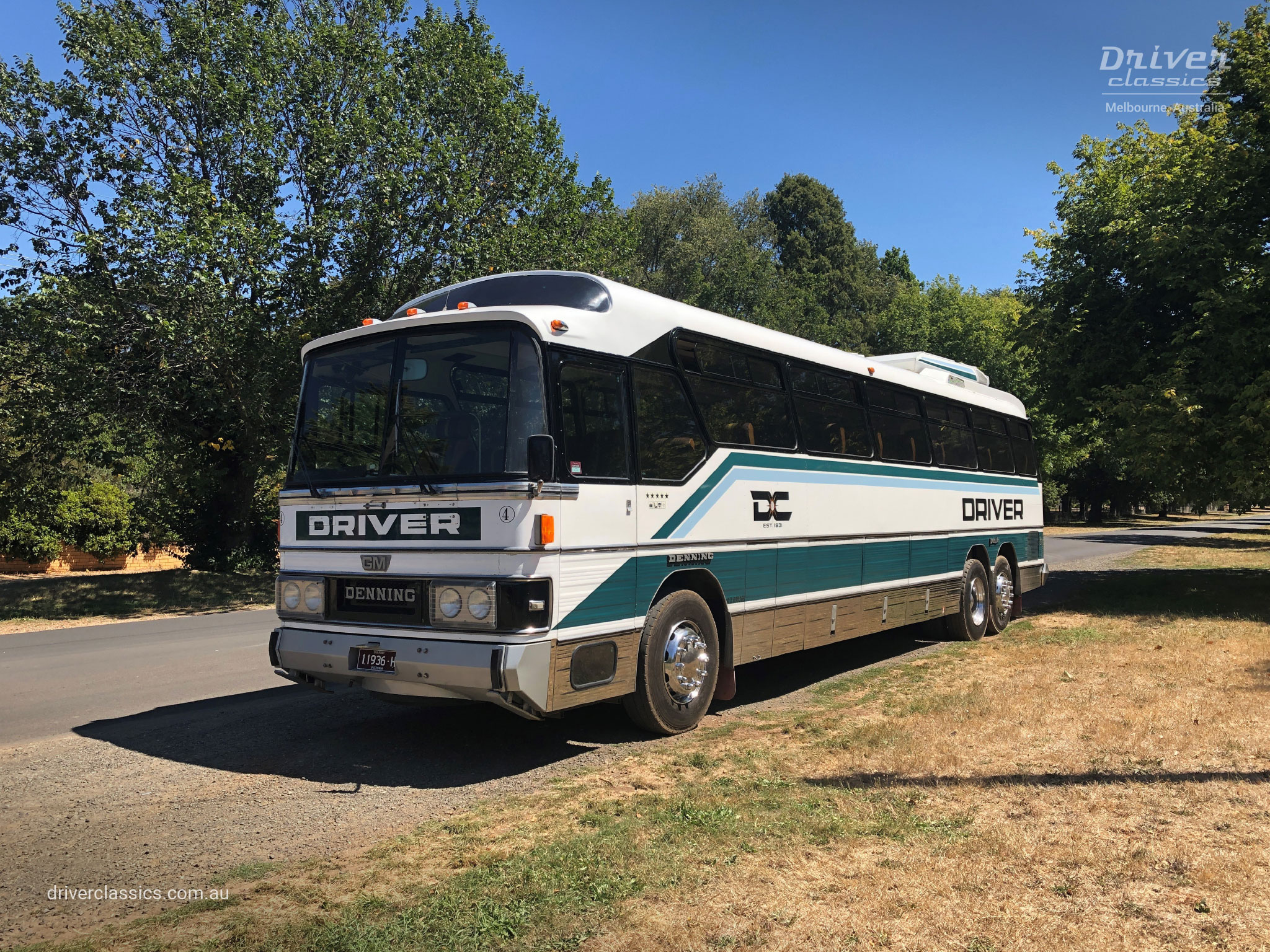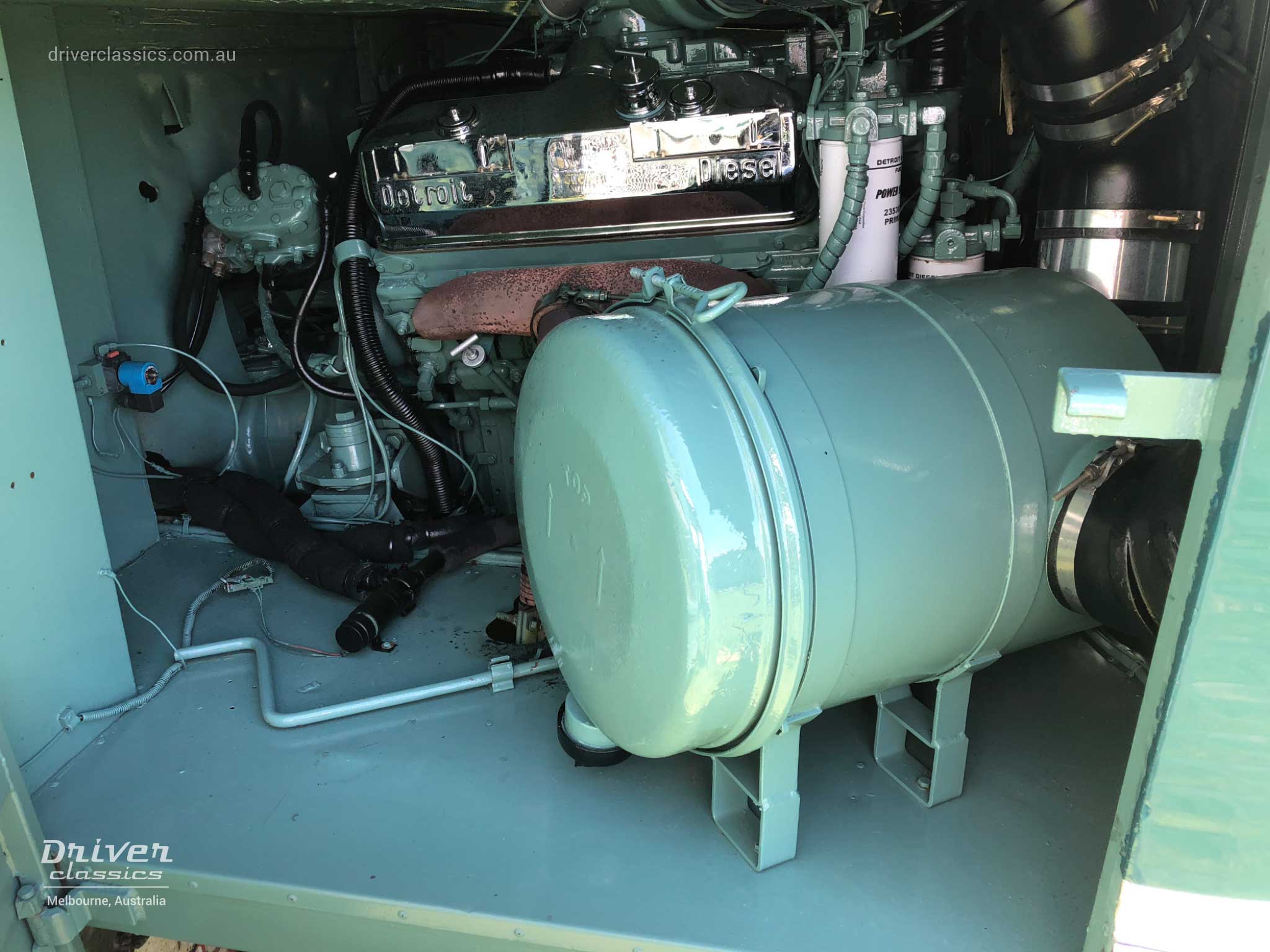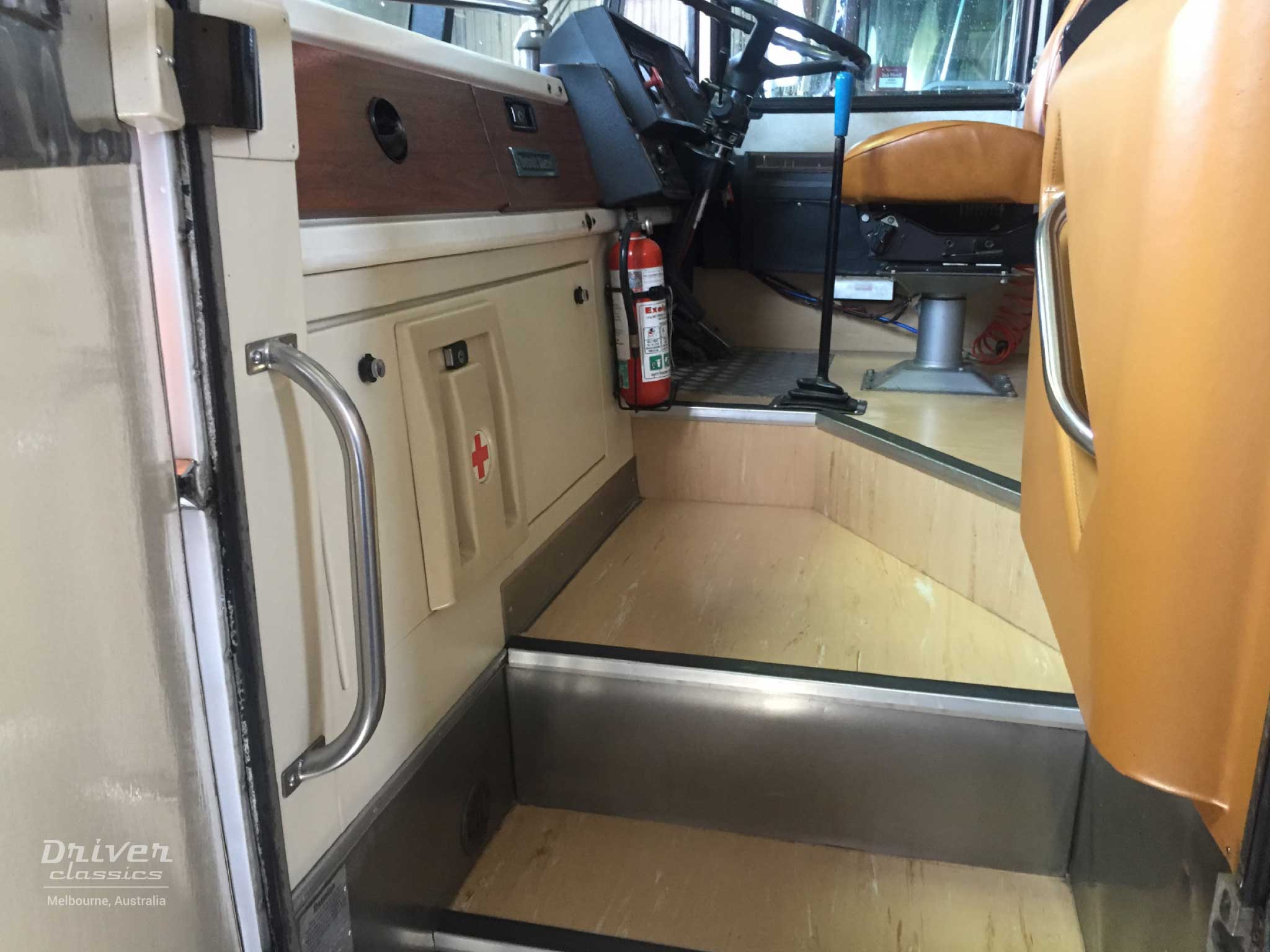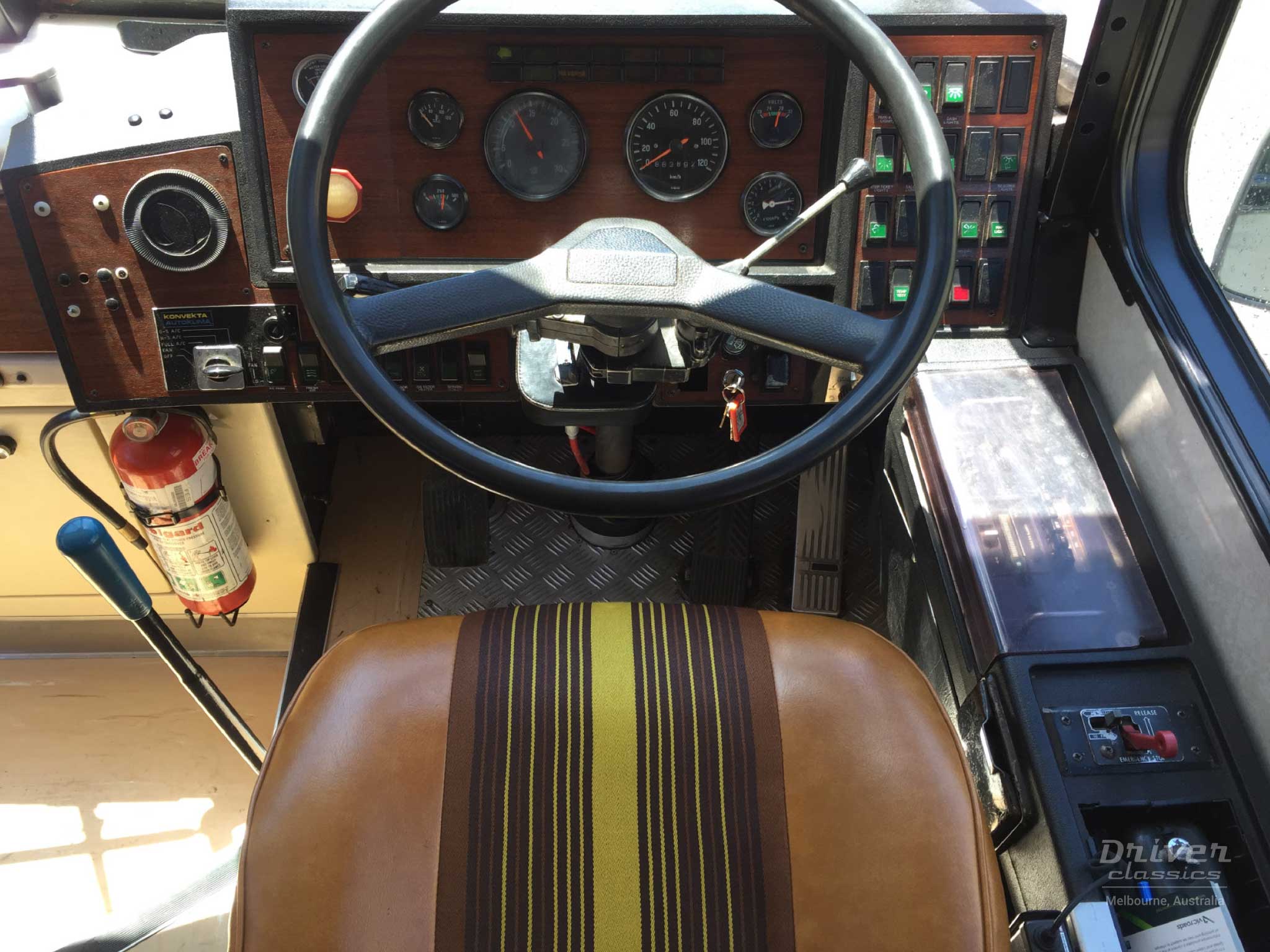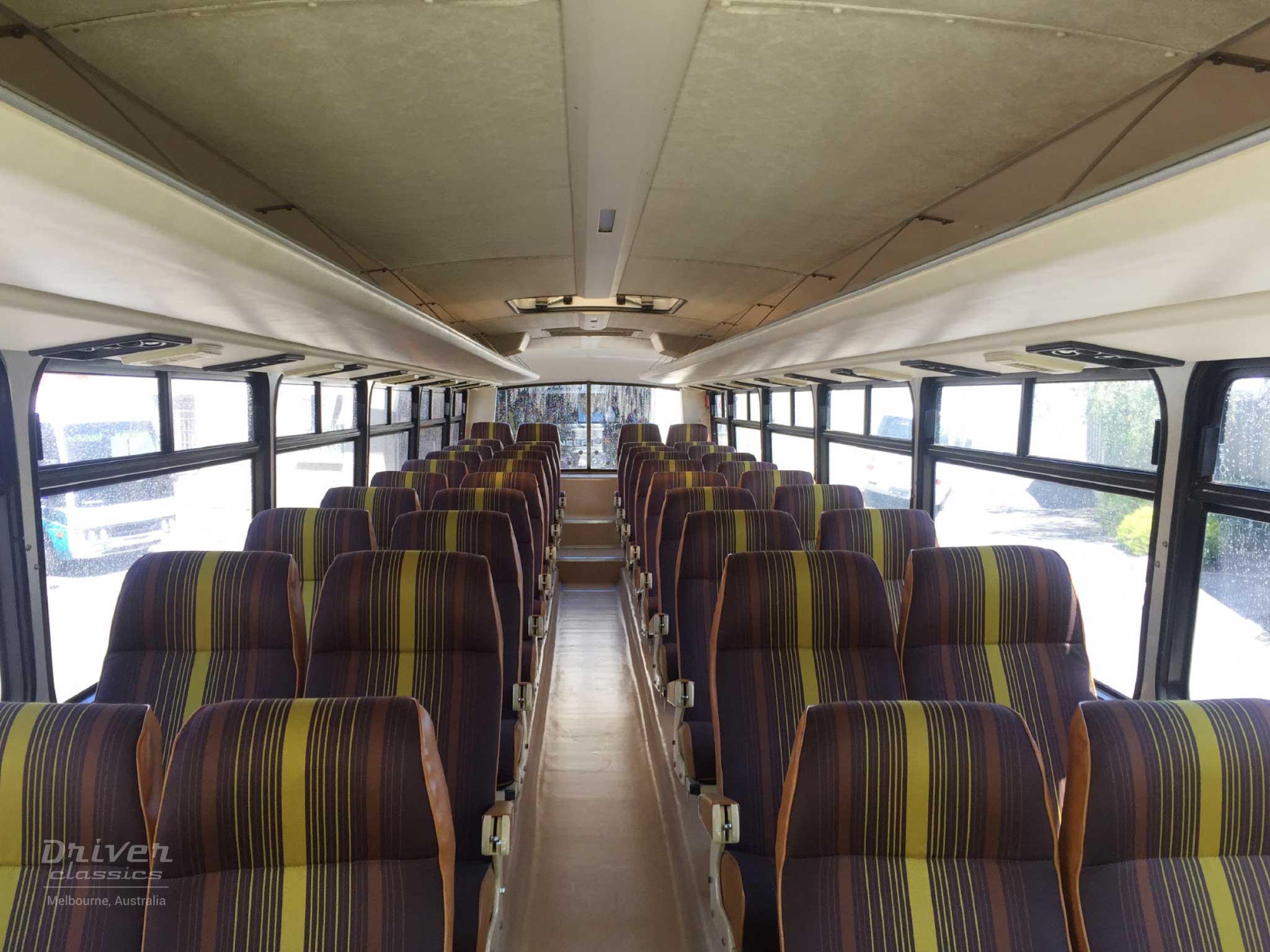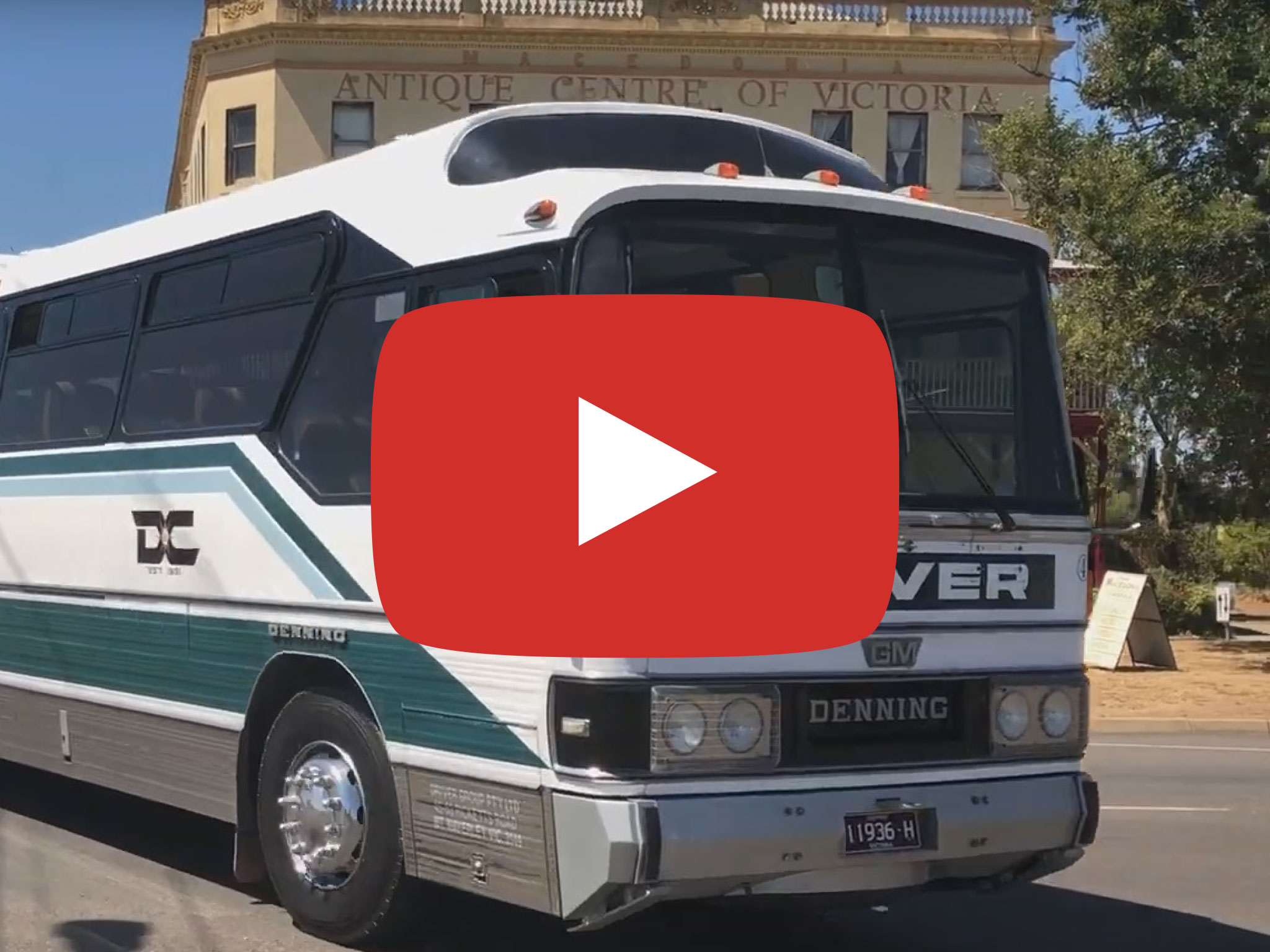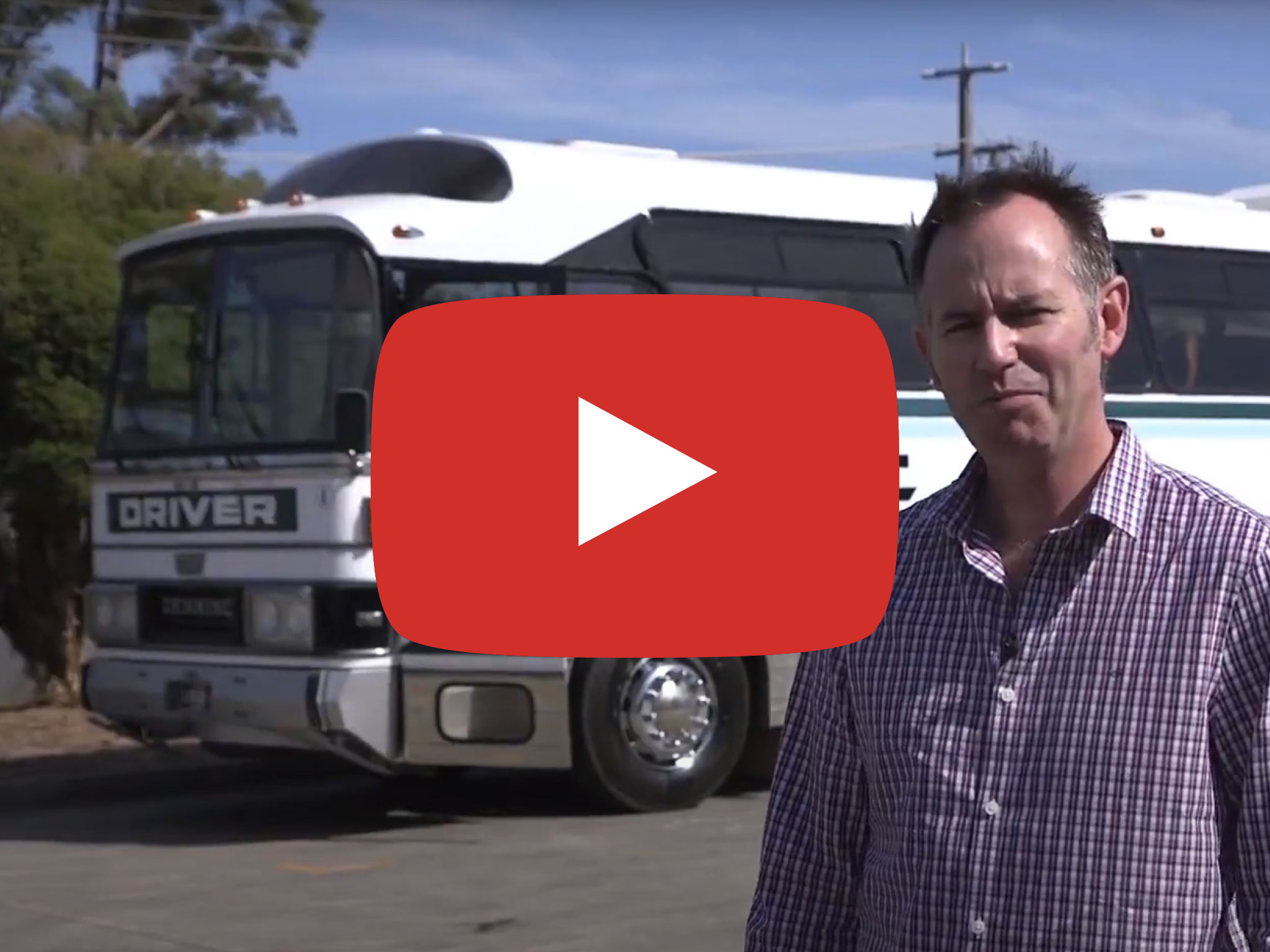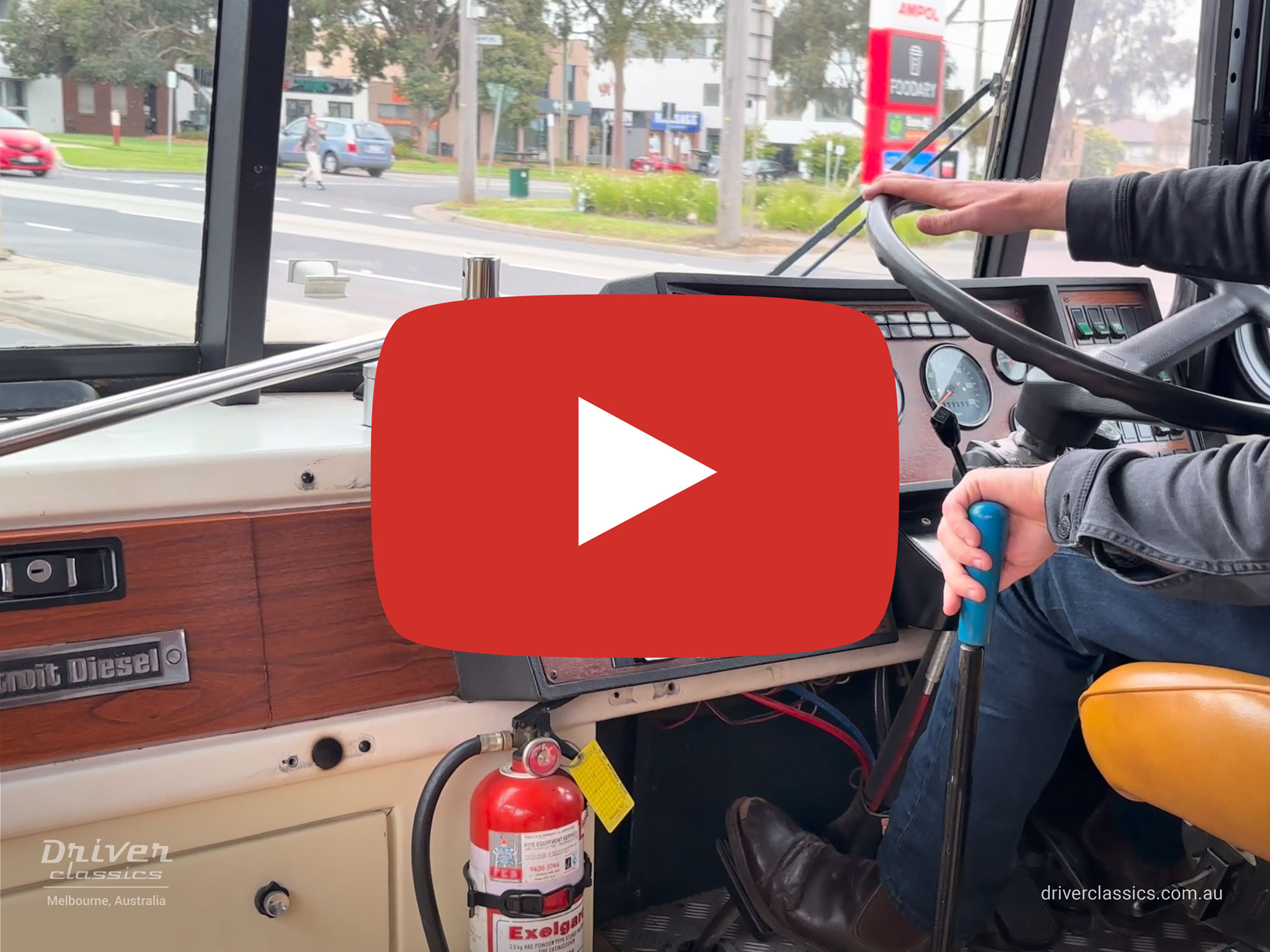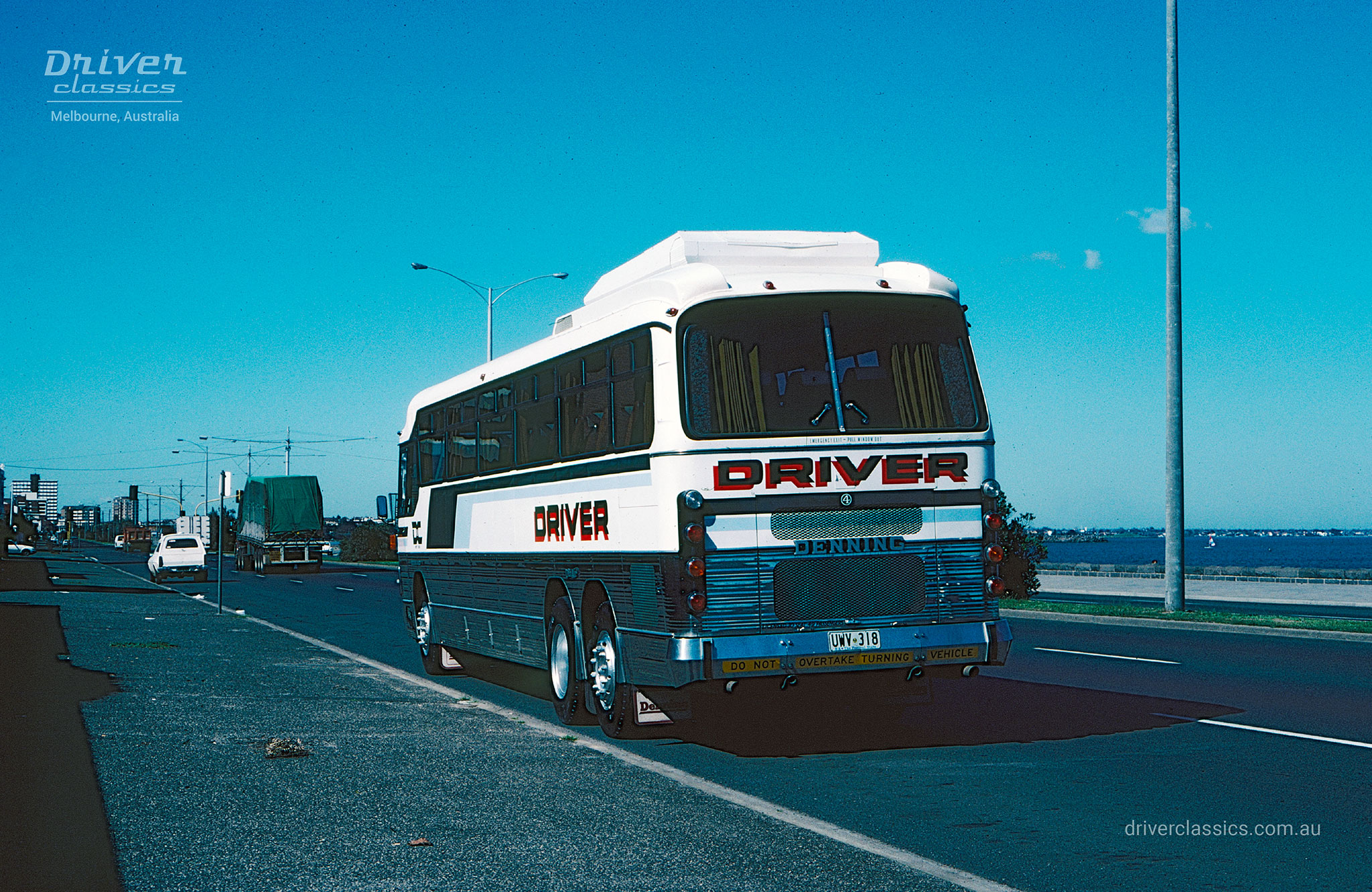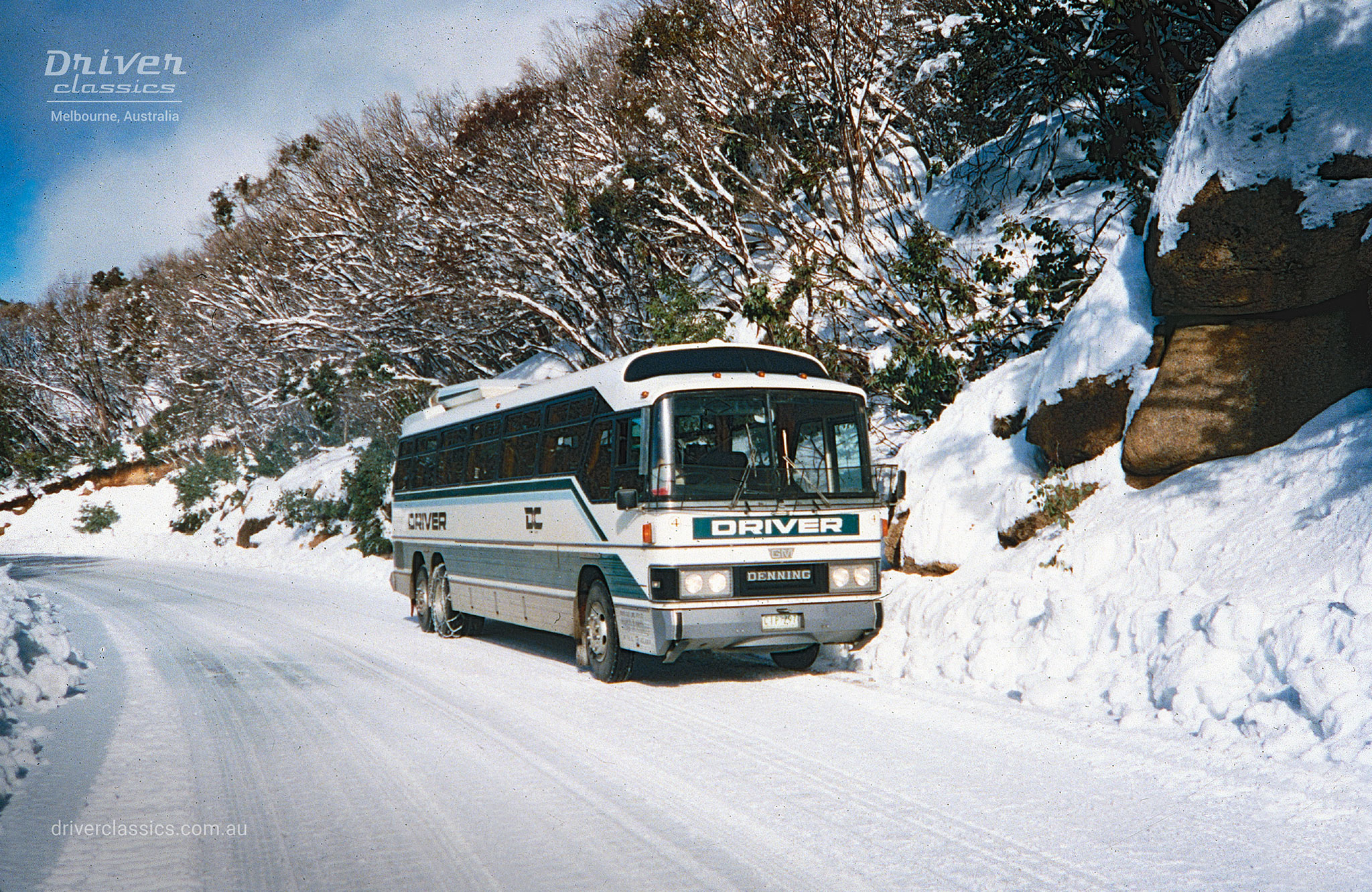1983 GM Denning DenAir Mono (Build #955, Fleet #4)
An Australian designed and built coach that could hold its own against imported rivals
(Click on photos to enlarge) - Images free to share and distribute but please acknowledge driverclassics.com.au
About This GM Denning

Our GM Denning DenAir Mono, #4 was purchased new by Driver Bus Lines in June 1983 and remained in service until 2008, making it one of the longest serving vehicles Driver Bus Lines has operated. In 2008, GM Denning #4 joined the Driver Classics heritage fleet. Its original registration was UWV-318, later CIP-297 then 1004-AO and currently 11936-H.
Driver Bus Lines had contacted Denning in July 1983 to place an order for a new coach to DBL specifications, essentially the same as GM Denning #17 including the Morris Woollen Mills blue fabric interior. However, when local Denning sales rep, Graeme Nichols came out to confirm the arrangement, he brought build #955, ex stock, built 5/83 to show to us.
The stock unit had some differences, the most noticeable being waist high stainless-steel panelling and a Morris Woolen Mills gold and brown fabric interior, which was not what we were looking for. However, Graeme offered an attractive price; a deal was done, and we had the vehicle delivered within days! The waist high stainless-steel panels necessitated a different paint scheme which was ultimately short lived. This GM Denning went on to perform its varying duties of Australia wide touring, local charter and school services with the utmost reliability.

This GM Denning DenAir Mono, build number 955, is powered by a GM Detroit Diesel V8 2 stroke engine, 568ci model 8V71, rear mounted in-line, with a 5 speed Fuller constant mesh transmission. The design was the the final interpretation of the GM Denning Mono series.
The Story
Denning was Australia’s most successful coach manufacturer from the early 1970s until the early 1990s, with operators nationwide purchasing GM Dennings. They had style, outstanding road performance, durability, reliability and although expensive compared to other vehicles of the day, they were still within reach of many coach operators. It was the coach that a large number of Australian operators aspired to, including Driver Bus Lines.
Founder Alan B Denning started out as a panel beater in 1950 and in 1956 began building bus bodies under the name of A B Denning and Co. Initially Denning built side loader bus bodies and in 1960, the first A B Denning coach body was built. Denning then focussed on chassis conversions with many front engine chassis’ becoming rear engine chassis’ to meet a demand for rear engine coaches that was not satisfied by suppliers at the time.
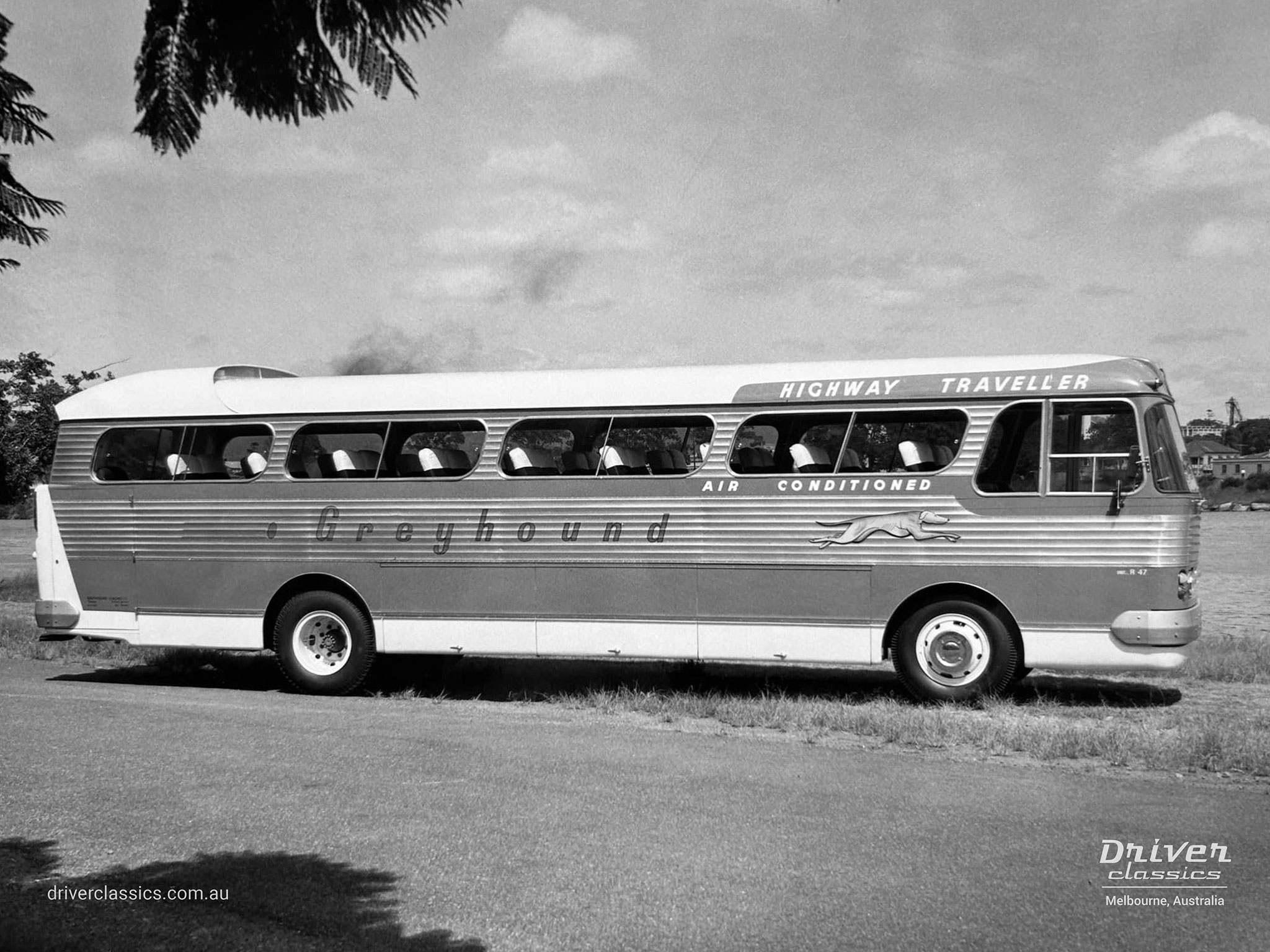
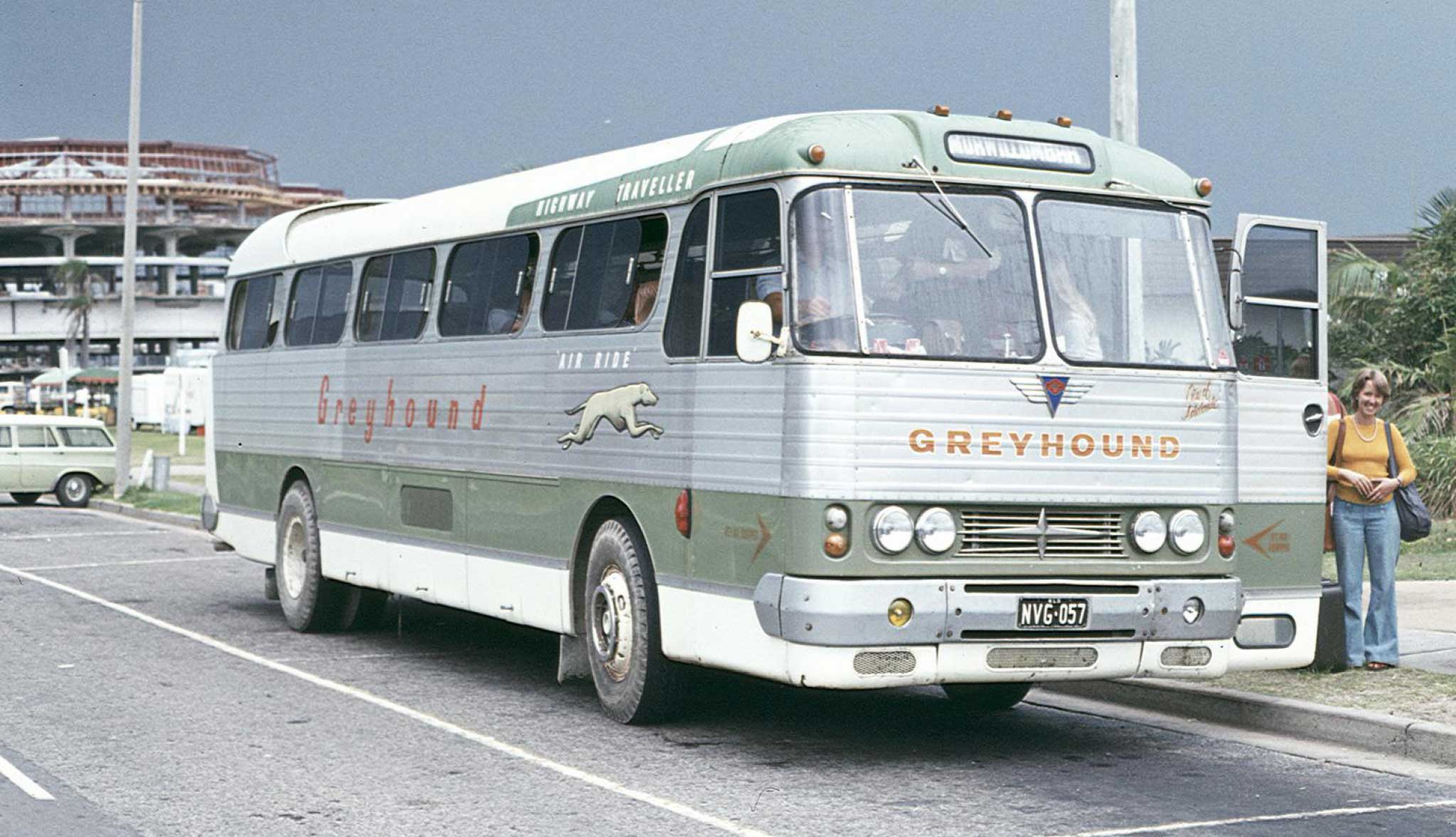
In 1962, Denning released its first body-on-chassis coach which it called the Highway Traveller. The Denning Highway Traveller had some subtle styling inspiration from the US 1950s GM PD 4104, which also happened to be called the Highway Traveller. Customers Rex Law of Redline and Russell Penfold of Greyhound had significant design input into the project. In 1960, both travelled to Europe and the USA looking at design trends and both were buyers and supporters of early Denning products.
Although the Highway Traveller was a body-on-chassis, it was not just any chassis but an extensively modified Commer Avenger front engine chassis. A Commer ‘Knocker’ TS3 two stroke diesel engine was fitted to the rear of the chassis, Balmoral Engineering Service in Brisbane extended the chassis wheelbase by 12 inches and increased the front overhang ahead of the front wheels, the gear box was replaced with a shorter model and the differential was turned upside down to accommodate the new rear engine design. The overall length was increased to 34 feet 3 inches and the stylish Denning body had 41 luxury seats and air conditioning. The seed was sown for what was to come.
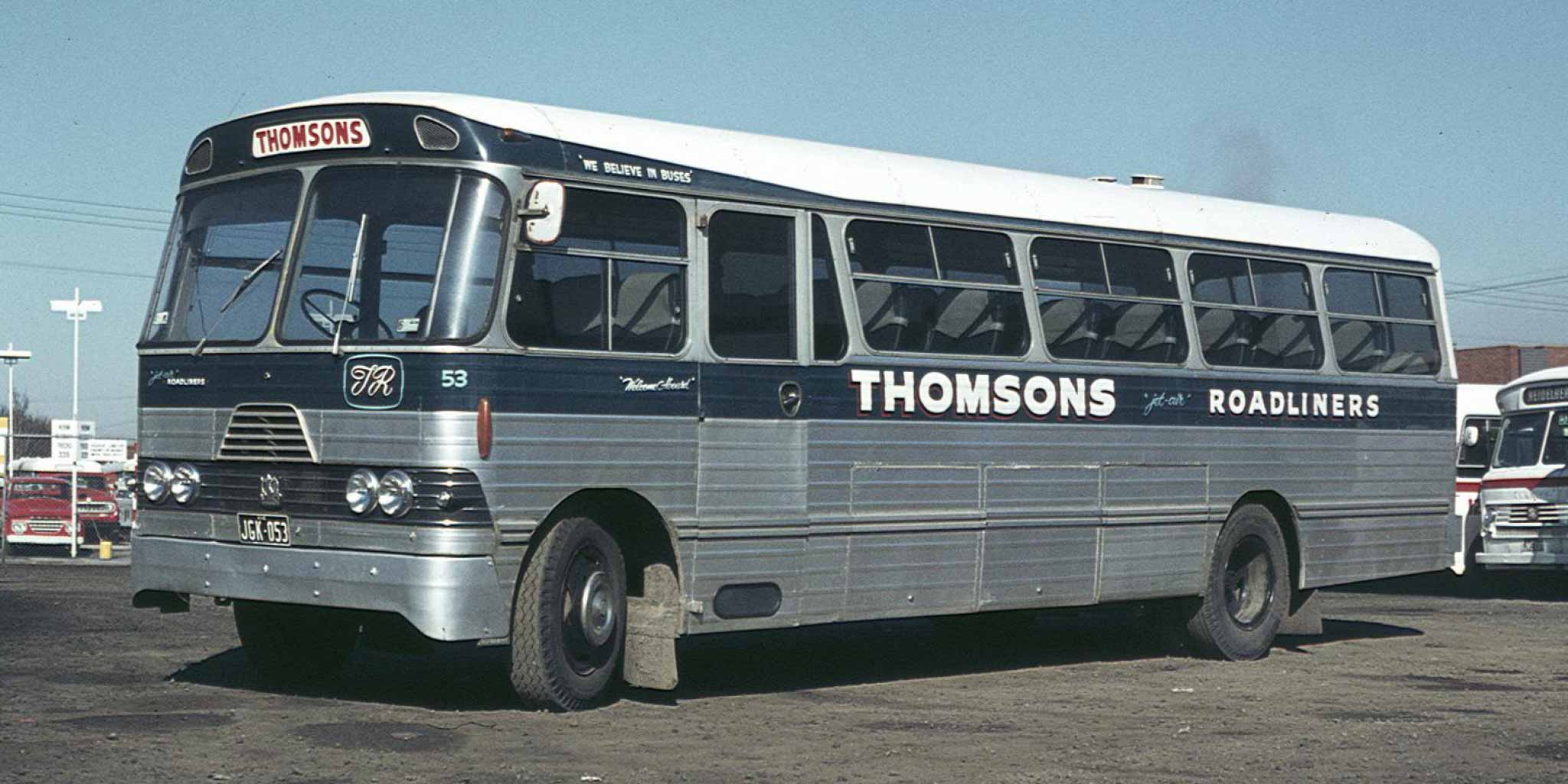
Denning then further refined and modernised the Highway Traveller into different interperetations that it continued to build until the introduction of its next landmark model.
Trade restrictions with the USA had been lifted in February 1961, allowing Melbourne based Ansett Pioneer to import GM coaches into Australia from the USA, creating a new benchmark for the industry. The GM PD-4106 coaches were a paradigm shift for the Australian coach industry and heralded a new age of modern coach transport in Australia that still holds true today. Queensland coach operators including Skennars, Kirklands, Greyhound and Redline along with coach builder Denning knew that something was needed locally to compete.
Enter the GM Denning Mono!
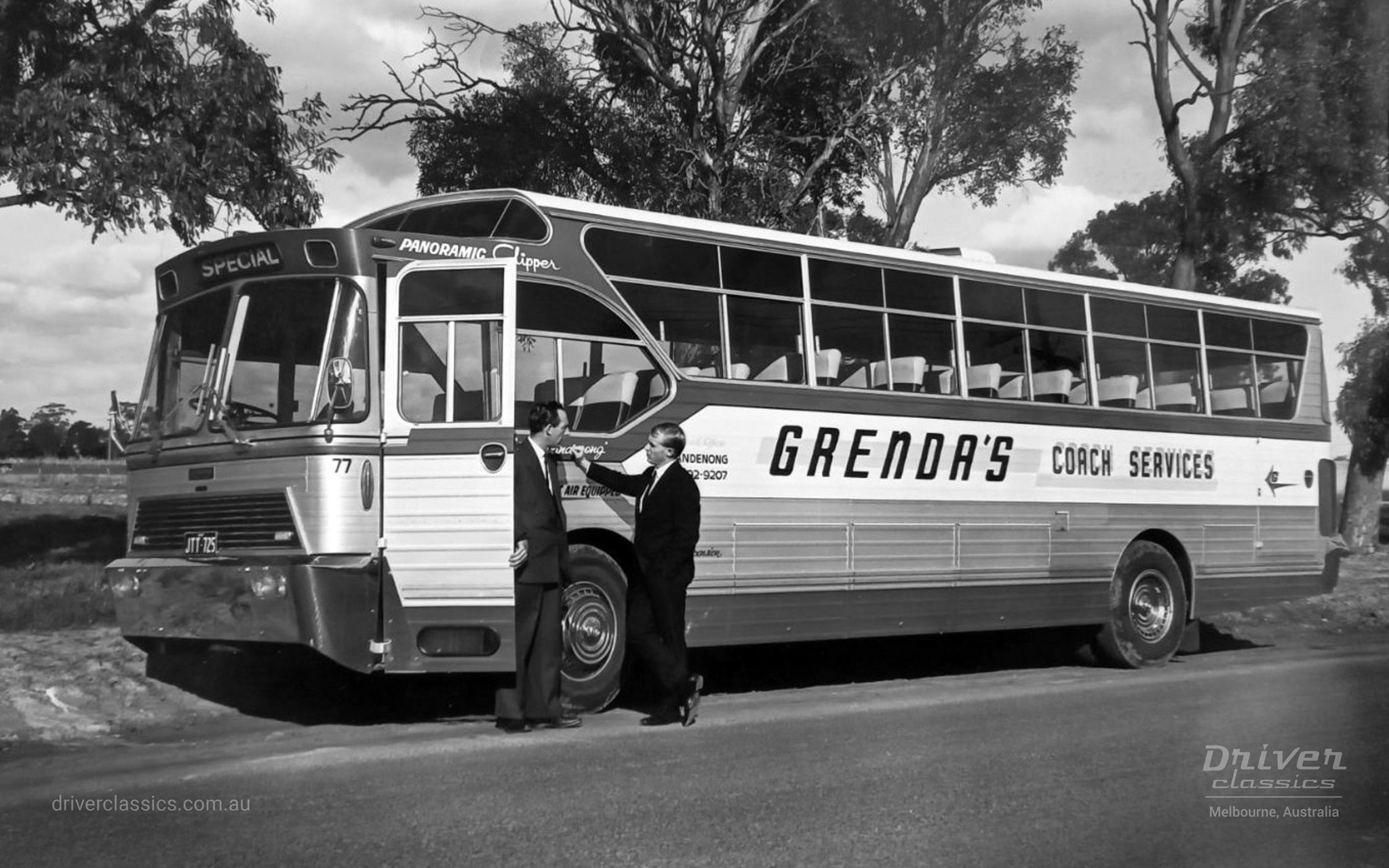
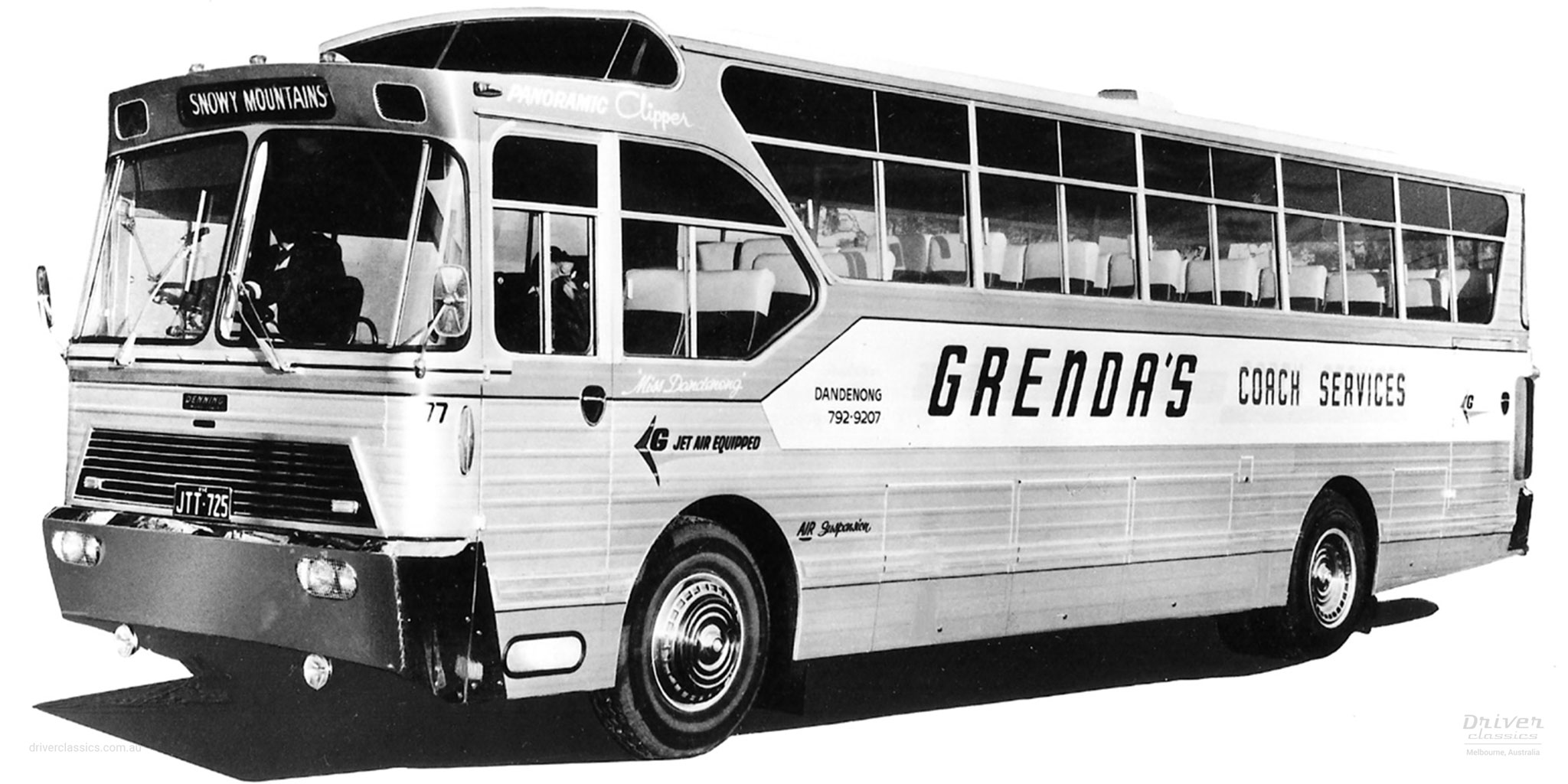
In 1966, Denning’s bold Square Line body-on-chassis design was introduced and in September of that same year, Denning built its first integral coach - the GM Denning Mono, also featuring the Square Line body design. This first GM Denning Square Line mono coach was built for Grenda's in Dandenong, Victoria and it boasted a prominent new styling feature…a raised roof deck-and-a half design which had the benefit of more under floor luggage bin capacity and better passenger vision. With its fluted aluminium panels and GM Detroit Diesel 6V53 power, it was absolutely stunning.

In 1968, Denning introduced another model series, now often referred to as the Classic series, following on from the early Highway Travellers and the Square Line. It also introduced its second generation GM Denning Mono integral coach which grew rapidly in popularity eclipsing sales of body on chassis models. Alan Denning sold A B Denning and Co to UK firm Leyland in 1969 and Alan then took on the role as Denning’s Managing Director until 1971, only to return again as Managing Director in 1973.

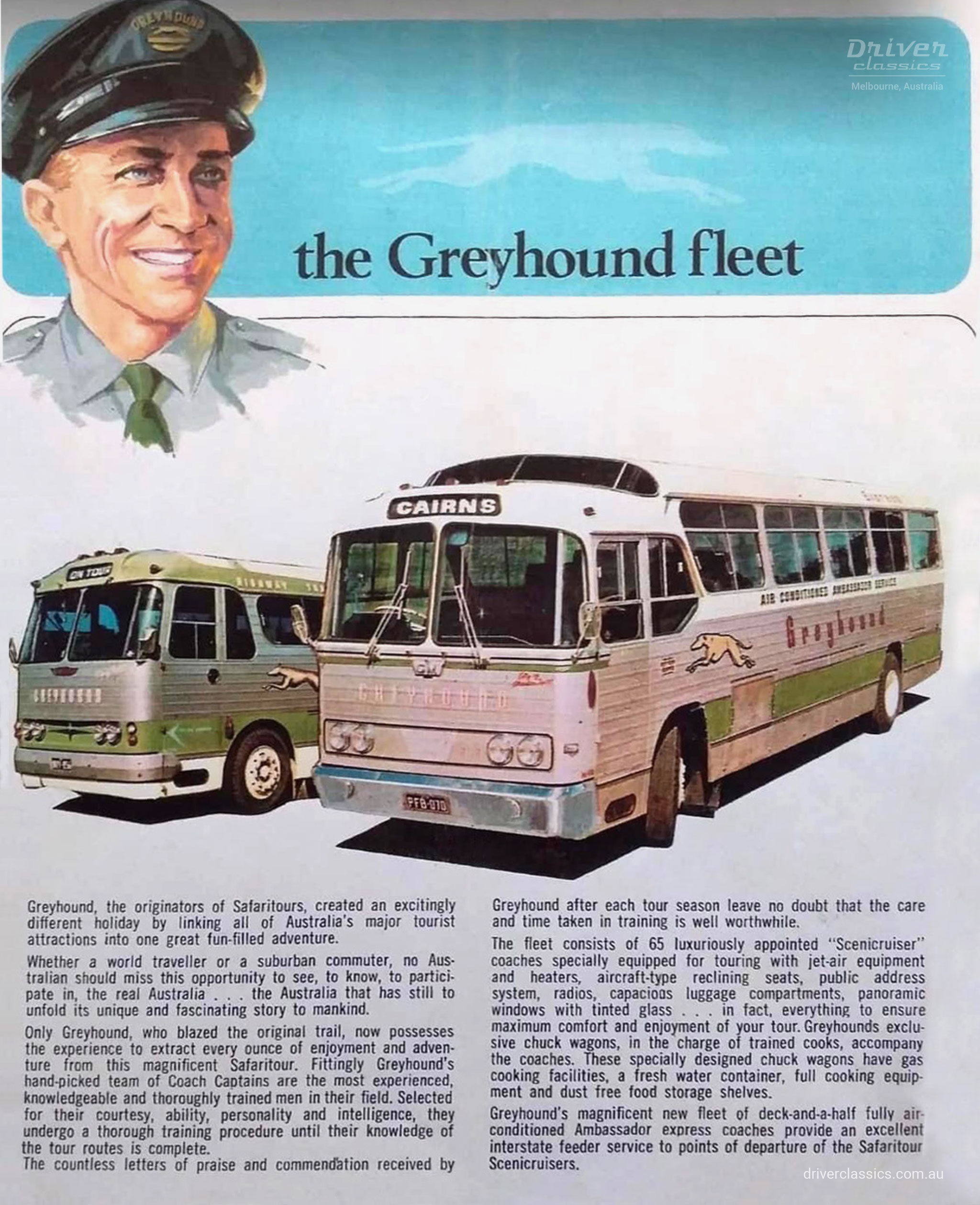
The GM Denning Mono was conceived to be a simplified and affordable version of the imported American GMs that Ansett Pioneer purchased during the 1960s. The only visible exterior branding on early edition Denning Monos was GM, which certainly signified its intent and pedigree. After Alan Denning permanently departed A B Denning and Co in 1976, the GM branding was dropped, however the industry always did, and still does, refer to the Mono as the GM Denning.
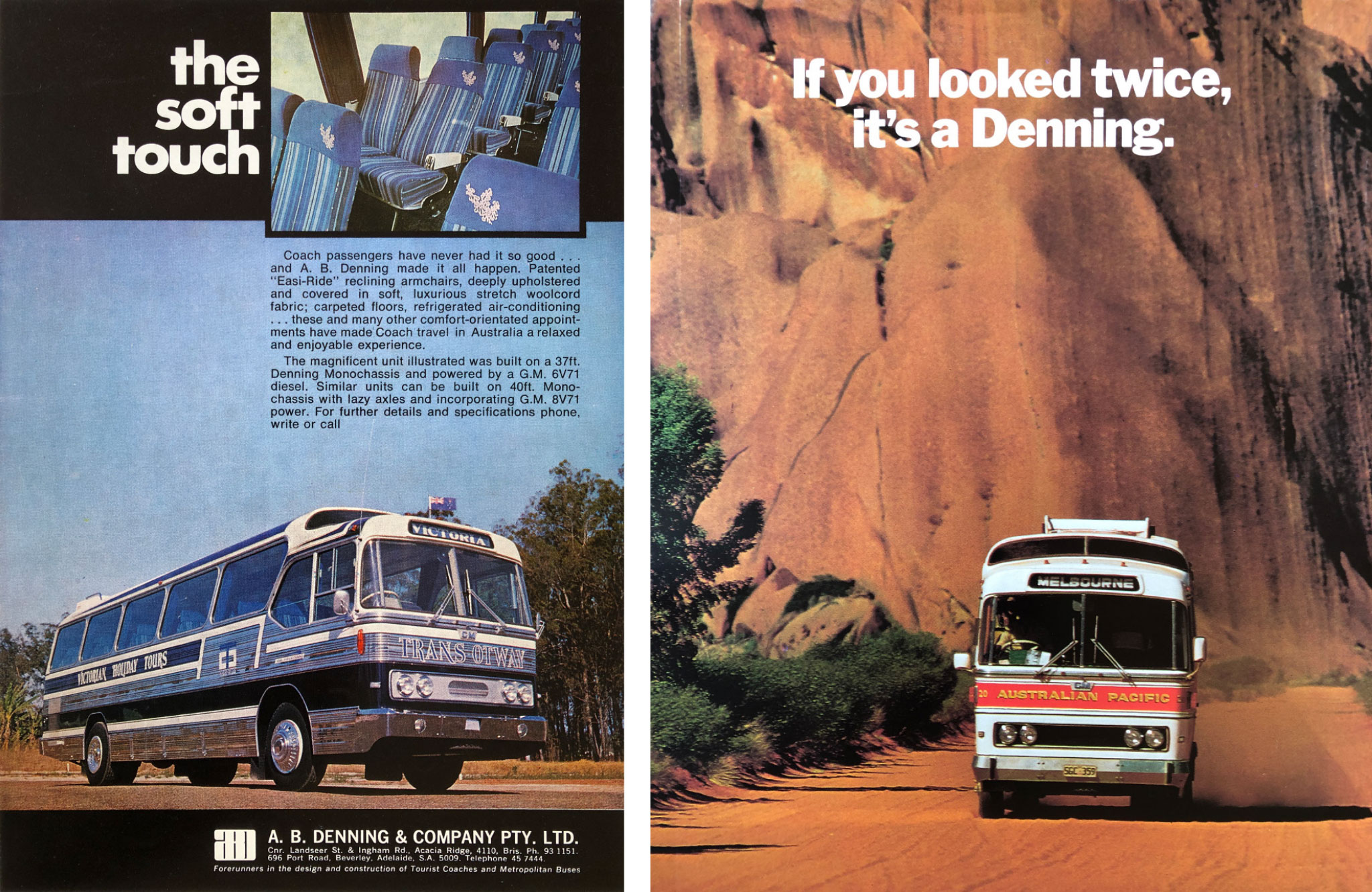
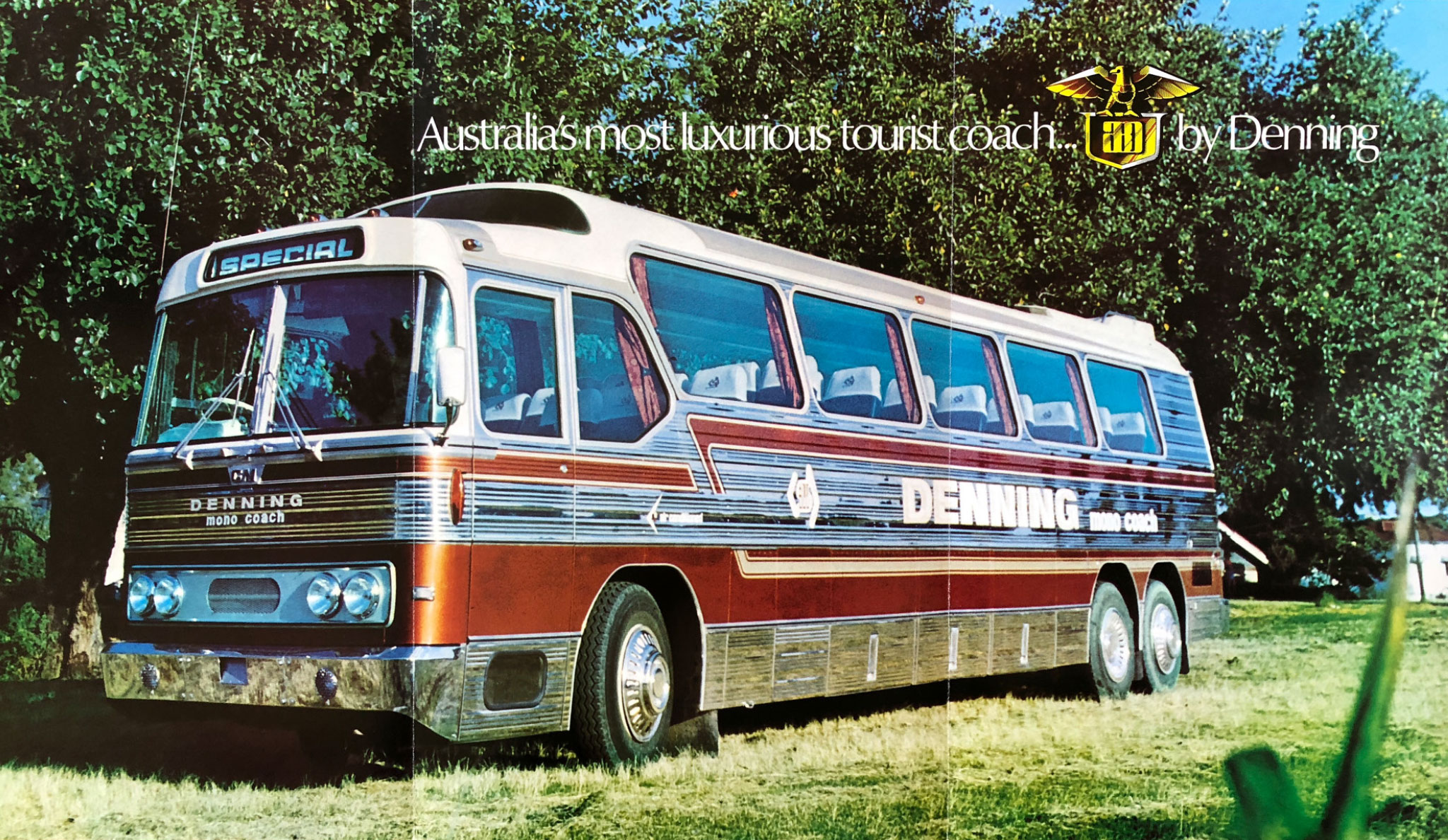

The Classic series GM Denning Mono was to become arguably, Denning’s greatest ever design and certainly its longest series in production. This latest GM Denning Mono appeared relatively conservative compared to the Square Line with a smooth, more rounded styling theme and a prominent deck-and-a half design that took inspiration from the imported GM PD 4107. It firmly placed Denning on the map and at the top of most company’s fleet purchase list.
Billed as ‘The Magnificent Australian’ with its large chrome bumpers and high shine stainless steel side panels, the 1971 GM Denning Mono made a strong statement about Denning’s design and the capability of Australia to build world class coaches. It was a true head turner, and commanded attention from the outset.
After Alan Denning’s departure in 1976, Denning partnered with Athol McKinnon to create the Denmak coach, a new version of the integral Monocoach. The partnership was short lived but the coach was not. The Denmak became the Domino Tourmaster and later the Austral Tourmaster and was in production for just on 20 years.
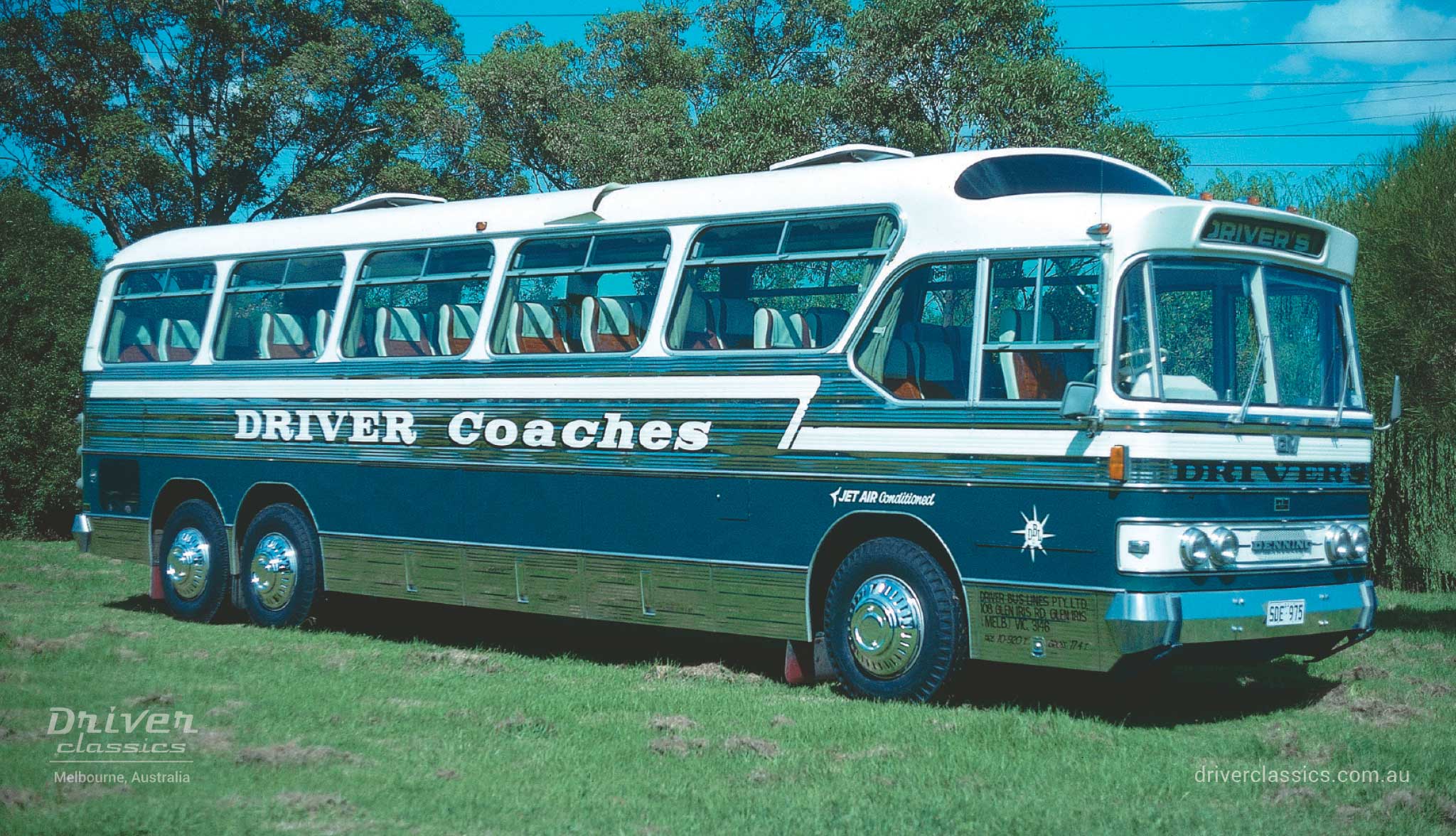
The first update of the classic series GM Denning Mono occurred around 1976 when a new forward sloping destination header was introduced, a wider front grille, a 2 piece rear window with a single centre divide replacing the 3 piece rear window, new front and rear aluminium bumpers replacing the large chrome bumpers, elimination of the roof window resulting in a non-see through deck-and-a-half design and full exterior ‘Denning’ only badging.

GM Denning Monos were extremely robust with leaf spring suspension, and in the new 3 axle 40 foot configuration, first introduced to Australia by Ansett Pioneer’s imported MCI MC7, the tag or lazy axle was air suspended. By 1978, Denning was offering an air over leaf suspension system which soon gave way to Denning’s first fully air suspended coach – the 1979 GM Denning DenAir Mono. In those days, Denning had the ultimate research and development regime – relentless travel in the remote Australian Outback under the most gruelling conditions imaginable, carried out by Denning’s own engineers. It was this severe testing and its’ on road prowess that earned Denning its reputation for ruggedness and durability.

Also in 1979, Denning released its DenFlex ‘chassis-only’ model for other builders to construct bodies on.

Throughout the 70s and 80s, the standard Denning power plant was a GM Detroit Diesel engine, being either a V6, model 6V71 or a V8, model 8V71, usually mated to a Fuller T905D 5 speed transmission. Around 1980, Denning began offering a large V6 GM Detroit Diesel engine in forty foot long coaches, model 6V92TTA as an option to the tried and true V8, model 8V71 engine.
The GM Denning Mono was marketed from 1971 until 1984 when it was replaced by the new, world class Denning Landseer (Please refer to ‘The Story’ section on our 1988 Denning Landseer for the continuing Landseer story). The final interpretation of the GM Denning Mono was perhaps the most notable with the deck-and-a-half roof line being brought further forward than its predecessors, giving quite a distinctive appearance. Other inclusions were a new dashboard that was to carry over to the Landseer, electric wipers replacing air operated, 4 tail lights instead of 3, a larger windscreen and a new front bumper and grille.
For full stories on the life of Alan Denning and A.B Denning company, please visit the Bus and Coach Society of Victoria’s web site at bcsv.org.au and click on ‘Buses over the years’ and also the Queensland Omnibus and Coach Society’s web site at www.qocs.org.au and click on History > Body builders > 'A.B. Denning and Co.'
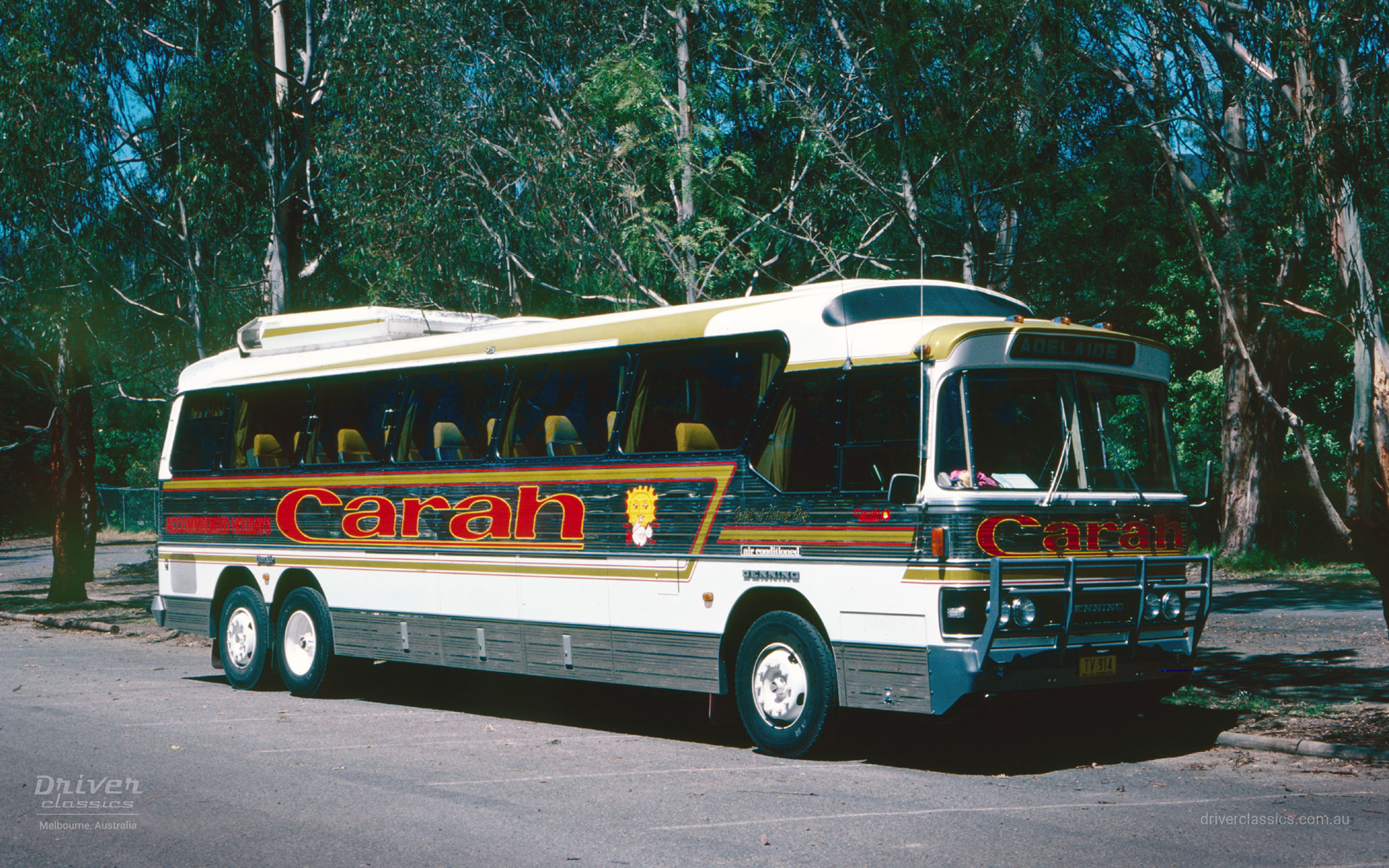
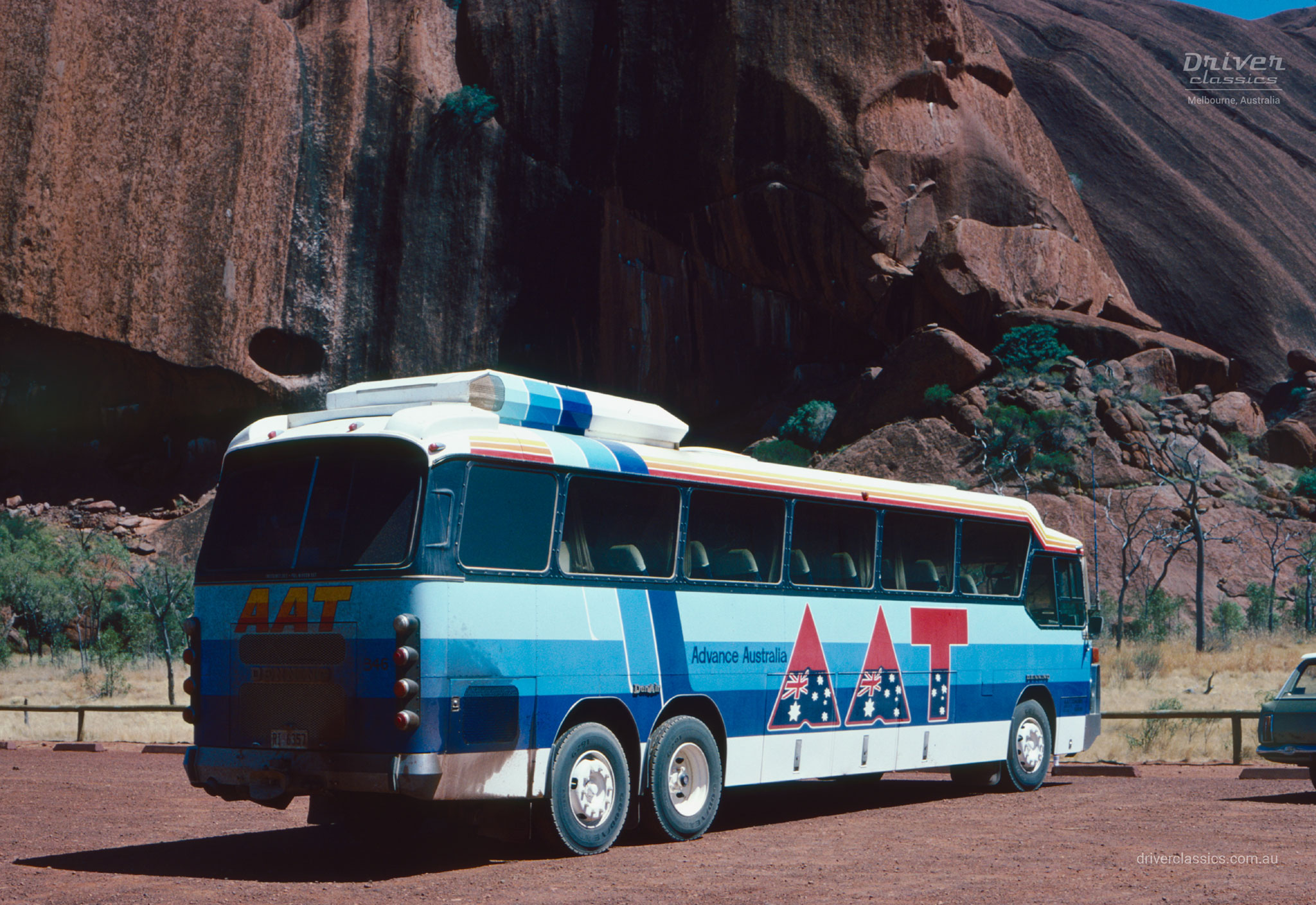
-

1936 Federal
-

1947 Bedford OB
-

1948 GM PD 4151
-

1954 Flxible Clipper
-

1959 Bedford SB3
-

1961 GM PD-4106
-

Ansair Scenicruiser
-

1968 GMC PD 4107
-

1972 MCI MC7
-

1976 MCI MC8
-

1983 GM Denning
-

1984 Eagle Model 10
-

1988 Denning Landseer
-

1989 Eagle Model 20
-

1977 Kenworth W925
-

1950 Dodge Pick Up
-

1959 Cadillac
-

1961 Cadillac
-

1962 Ford Thunderbird
-

1968 Ford Fairlane
EX HERITAGE FLEET
